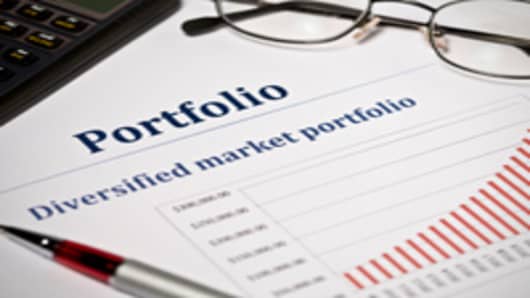The bounce instocksin 2010, and the drop in bond pricesin the year’s final months, means one sure thing: most investment portfolios need a review and re-adjustment.
That’s because big moves in the market in 2010 have likely shifted the mix of assets in most portfolios, so they no longer reflect individual investment goals.
“Look at the positions that you’ve had big runs on,” advises Carlo Panaccione, president of Navigation Group in Redwood Shores, California. “You don’t want to have any individual position that’s much over 5 percent of your portfolio.”
Now also provides an opportunity for investors who missed the stock market rally to step off the sidelines.
“Start to see how you might average back into the market, with the goal of getting to a portfolio that’s your proper risk level,” says Panaccione.
Getting to the proper risk level, with the right mix of stocks, bonds and cash, is the key to investment success, financial advisers say, and the beginning of the year is as good a time as any to rebalance the assets in a so-called asset allocation framework, or for investors to create an asset allocation plan if they don't have one already.
“It’ll be the key determinant for how your portfolio behaves,” says Christine Benz, director of personal finance at Morningstar, the investment research firm in Chicago.
To devise an asset allocation plan, investors can either work with a financial adviser, find a tool on the web (consider BankRate’s Asset Allocation Calculator among others), or search out mutual funds with target maturity dates to use as a guideline, Benz says. Most major fund companies, including Fidelity and Vanguard, have these funds, which allocate assets according to a future date.
For a 50-year-old, with 15 years until retirement, the asset allocation in the Vanguard Target Retirement 2025 fund offers this guideline: 76 percent of assets in stocks, and 26 percent in bonds.
Once an asset allocation plan is in place, it's important for investors to diligently stick with the right mix for their own individual circumstances, financial advisors say, and not go piling into asset classes that are supposedly headed higher, or abandoning others that seem too risky.
Diversify Stock Holdings
For stocks, Dan Yu, a director in EisnerAmper's personal wealth advisory group, recommends investors add international stocks, including emerging markets, as well as a mixture of small-cap and large-cap stocks, to their stock allocations, depending on how much risk the investor can shoulder.
That will depend, of course, on how many years an investors has left before retirement. A younger investor should have a higher percentage of emerging markets and small-cap stocks than an investor nearing retirement, he says.
“You reduce the more volatile asset classes as you get older,” Yu says. “It’s just common sense, as you get older, you get more defensive.”
Investors with riskier investment appetites, can potentially enhance returns with bets on individual stock sectors in addition to a designated allocation to stocks. For instance, an investor who thinks financials have room to move higher in the first quarter, could allocate a small percentage of assets to this sector.
“You don’t want to bet the house on it, but I doesn’t mean you couldn’t take a 3 percent to 5 percent position in something you believe in,” Panaccione at Navigation Group says.
Most advisers recommend a portfolio tune-up once, maybe twice a year (if conditions are volatile), but David Hefty CEO of Hefty Wealth Partners in Auburn, Indiana, employs a “tactical asset allocation” strategy for his clients, which involves averaging out big gains and losses throughout the year by using technical analysis to forecast potential movements in asset classes.
In the fourth quarter, Hefty’s trading systems signaled the fall in bond prices, so the firm sold, and as a result stemmed losses to 1 percent, he says.
For most investors, a conventional way for smoothing out gains and losses is "dollar cost averaging," the strategy of designating a set amount of money to be withdrawn from a checking account each month and allocated to specific investments, whether a 401(k), savings account or college savings plan, says Benz at Morningstar.
“The time you least feel like investing may be a tremendous time to put money into your investments,” Benz says. “It puts in place something to override your emotional responses to the market, and it helps override greed too.”
Too Late For Bonds?
What about bonds?
An asset allocation plan may help now for investors wary of bonds, who see interest rates, after an enormous and sometimes unexpected rally, heading higher, which will continue to send bond prices lower.
In fact, Hefty is telling his clients: “Don’t consider bonds a safety net, but consider them an investment vehicle that has the opportunity to lose money.”
While true, many pros say even in a rising rate environment, bonds have a place in investor portfolios. Investors that own individual bonds can stick with them to maturity, then recoup the principal and reinvest the proceeds in bonds with higher yields, say strategists.
A bond fund, however, can lose principal, but bond fund managers can also swap into higher yielding bonds, buffering the loss, Benz wrote in a November article for Morningstar.
Moreover, bonds will still be less volatile than stocks, Benz says. "I do think you have to keep some of those worries in perspective and understand swings you see in a high quality bond portfolio will be less than you have in stocks," she says in an interview.
Investors worried about bonds could consider floating-rate bank-loan funds, which invest in baskets of bank loans with rates that reset along with the London Interbank Offered Rate, or Libor, for their bond allocation. “That gives them the ability to stand tough in the face of rising interest rates,” Benz says.
Another option are municipal securities, which make sense for investors in higher tax bracketsin particular. While some analysts believe muni bonds face potential default as states and cities struggle under debt loads, others believe the market has sold off quite a bit, creating opportunities. Investors can test whether muni bonds make economic sense for their own circumstances with a tax-equivalent yield bond calculatoron Morningstar's website.
Yu at EisnerAmper recommends munis for his clients, although he advises them to stay clear of bonds issued in high risk states like California, Florida, New York and New Jersey. He also recommends buying short maturities.
“I have bonds that mature in 2011, 2012, 2013, so every year I have an event that causes us to relook,” Yu says.
The adviser prefers his high net-worth clients buy individual bonds, instead of mutual funds, to avoid concerns with price fluctuations should rates rise. To make buying individual bonds practical, however, an investor would need to have at least $2 million to $3 million to allocate to the sector, he says.
Investors with an asset allocation plan in place should make major changes in their mix of bonds, stocks and cash at most every five years. Otherwise, fine tune, but only if gains and losses have resulted in major changes of 3-to-5 percentage points, advisers say. If an investor's 10 percent allocation to large-capitalization stocks falls to 6 percent, Yu says, it's time buy more large caps.
"It gives you some discipline, and you take some of the emotion out of the investing," he says.



